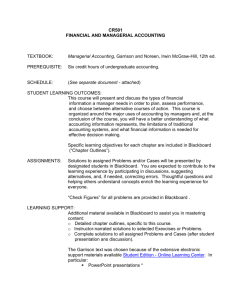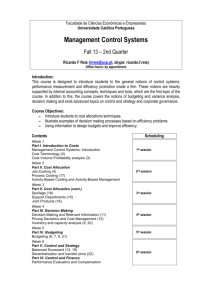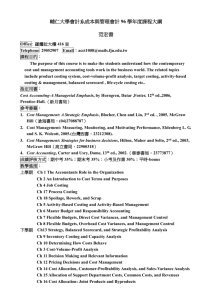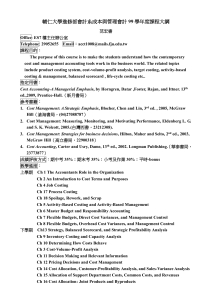Activity-Based Costing
advertisement
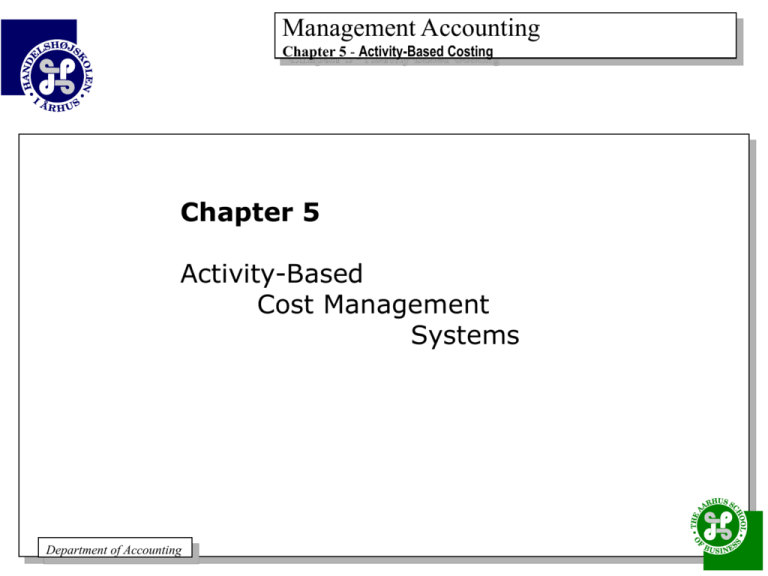
Management Accounting Chapter 5 - Activity-Based Costing Chapter 5 Activity-Based Cost Management Systems Department of Accounting Management Accounting Chapter 5 - Activity-Based Costing Chapter 5 objectives: To be able to: 1. 2. 3. 4. 5. 6. 7. 8. 9. 10. 11. Understand how traditional cost systems, using only unit-level drivers, distort product and customer costs. Describe why factories producing a more varied and complex mix of products have higher costs than factories producing only a narrow range of products. Design an activity-based cost system by linking resource costs to the activities performed and then to cost objects, such as products and customers. Appreciate the role for choosing appropriate activity cost drivers when tracing activity costs to products and customers. Use the information from a well-designed activity-based cost system to improve operations and make better decisions about products and customers. Understand the importance of measuring the practical capacity of resources and the cost of unused capacity. Assign marketing, distribution and selling expenses to customers. Analyze customer profitability. Appreciate the role for activity-based cost systems for service companies. Discuss the barriers for implementing activity-based cost systems and how these might be overcome. Understand how ABC-costing works in the organizational structure of Arla Foods Amba Department of Accounting Management Accounting Chapter 5 - Activity-Based Costing Traditional Manufacturing Costing Systems • Tends to underestimate resources required for specialty low -volume costs • Tends to overestimate the resource cost of high volume standard products Exhibit 5-1, pages 160-162 Department of Accounting Management Accounting Chapter 5 - Activity-Based Costing Activity-Based Cost Management Systems Definition: System based on activities that links organizational spending on resources to the products and services produced and delivered to customers Department of Accounting Management Accounting Chapter 5 - Activity-Based Costing Activity-Based Cost Management Systems • Tracing costs to activities • Tracing costs from activities to products • Selecting activity cost drivers Department of Accounting Management Accounting Chapter 5 - Activity-Based Costing Tracing costs to activities • Step 1 Develop activity dictionary = the list of major activities performed by the plants resources (use verb action words as handle, perform and support to describe activities) • Step 2 Map resource expenses to activities in dictionary Exhibit 5-2, page 166 Exhibit 5-3, page 166 Exhibit 5-4, page 167 Department of Accounting Management Accounting Chapter 5 - Activity-Based Costing Tracing costs to activities The process of identifying the link between expenses and activities provide knowledge/insight about 1. The cost of performing a specific activity 2. Transforming focus from what the money was being spent on to what the resources acquired by the spending were actually doing (exhibit 5-4, page 167) Department of Accounting Management Accounting Chapter 5 - Activity-Based Costing Tracing costs to activities Operational activity-based management: The process of using information collected by the ABC-system at the activity level to identify promising opportunities for reducing costs in indirect and support activities. Department of Accounting Management Accounting Chapter 5 - Activity-Based Costing Tracing costs from activities to products Purpose: The activity expenses should be related in some way to the demands for the activities by individual products. Activity cost drivers: Measures that identify the linkage between activities and cost objects. They serve as quantitative measures of the output of activities. Activity cost driver rate: The amount determined by dividing the activity expense by the total quantity of the activity cost driver. Department of Accounting Management Accounting Chapter 5 - Activity-Based Costing Tracing costs from activities to products Establishing activity cost drivers: Exhibit 5-5, page 169 Exhibit 5-6, page 169 Calculationg activity cost driver rates: = activity expense total quantity of activity cost driver example Cost driver = handle production runs Cost driver rate = Department of Accounting $66.000 Number of runs = 66.000 150 = $440 Management Accounting Chapter 5 - Activity-Based Costing Tracing costs from activities to products Assigning activity expenses to products: Exhibit 5-7, page 170 Creating a full Activity-Based Costing Product Profitability Report: Exhibit 5-8, page 170 Bill of activities: The set of activities and costs associated with individual products or customers. Department of Accounting Management Accounting Chapter 5 - Activity-Based Costing Tracing costs from activities to products Activity-based management (ABM): An approach to operations control that involves the five-step process of • • • • • identifying the process objectives charting activities clasifying activities continuously improving processes eliminating activities whose costs exceed their value. Department of Accounting Management Accounting Chapter 5 - Activity-Based Costing Selecting activity cost drivers Accuracy versus the cost of measurement 3 different categories of activity cost drivers: Transaction drivers: Used to count the frequency of an activity, the number of times an activity is performed. Example - cost per customer (assumes all customers cost the same). Duration drivers: Represent the amount of time required to perform an activity. Example - cost per customer hour (assume different customers use different amounts of sales resource time, but each hour of support time costs the same). Intensity drivers: Used to directly charge for the resources used each time an activity is performed. Example - actual cost per customer (actual or estimated time and specific resources, including travel committed to specific customers). Department of Accounting Management Accounting Chapter 5 - Activity-Based Costing Measuring the Cost of Resource Capacity Practical capacity: The amount of work that can be performed by resources supplied for production or service. Cost of unused capacity: An expense determined by the amount of resources unused during production. Example: Capacity 176 production runs Actual is 150 production runs Amount = $66.000 Amount = $66.000 cost driver = $375 cost driver = $440 The rate of $440 contains a cost of unused capacity in the amount of $65. Where to assign the cost related to unused capacity? Case: Arla Foods Amba overhead and capacity. Department of Accounting Management Accounting Chapter 5 - Activity-Based Costing Marketing, Selling and Distribution Expenses: Tracing costs to Customers Many of the MSDE costs do not relate to individual products or product lines, but are rather associated with individual customers, market segments and distribution channels. The Anders Wire Company, page 177-179 Department of Accounting Management Accounting Chapter 5 - Activity-Based Costing Managing Customer Profitability Exhibit 5-10, page 180 Discussing types of customers and what can be done to make profits acceptable. Department of Accounting Management Accounting Chapter 5 - Activity-Based Costing Service Companies and Activity-Based Costing ABC is highly relevant for service companies since they typically generate indirect and overall fixed costs. Consequently there are no direct product or customer costs to serve as convenient allocation bases. Exhibit 5-11, page 184 Department of Accounting Management Accounting Chapter 5 - Activity-Based Costing Implementation Issues • Lack of clear business purpose • Lac of senior management commitment • Delegating the project to consultants • Poor ABC model design • Individual and organizational resistance to change Department of Accounting


